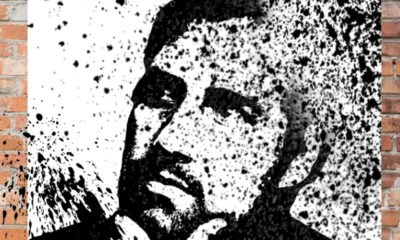Opinion
Syria Exploring The Embrace of Bitcoin
Published
14 hours agoon
By
admin

Syria’s economy is in a bad state, to put it very mildly. Not only has the Middle Eastern nation been battered by over a decade of war, the Assad regime, which has been in power since 1971, has now been overthrown by a jihadist group. The conflict, which began in 2011, has devastated infrastructure, displaced millions, and led to economic sanctions from Western nations. These factors have crippled the local economy and trade, leading to severe inflation. The Syrian pound (SYP), which was once relatively stable, has lost over 99% of its value since the war began whilst hyperinflation has turned basic goods, like bread and fuel, into luxuries for ordinary citizens.
In the face of these challenges, Syria has struggled to maintain monetary stability, with dwindling foreign currency reserves and limited access to global financial systems. However, hope may now be on the horizon since it has been announced that the Middle Eastern nation is planning to legalise Bitcoin, explore using it to back its national currency and use its energy reserves to mine it. This ground-breaking policy could transform not only Syria’s economy but serve as a potential model for other nations in the region that are also grappling with inflation and economic instability.
Bitcoin’s decentralized nature makes it immune to geopolitical pressures and the monetary policies of individual nations. This independence offers Syria a way to circumvent traditional financial systems dominated by Western powers and sanctions. Legalizing Bitcoin, and potentially backing the Syrian pound with it, will not only facilitate monetary stability but will do so in a manner that allows the struggling nation to become somewhat immune from regional economic shocks. Bitcoin could also allow citizens and businesses to transact with greater confidence and open up trade channels with countries around the world.
This does make one wonder, localised fiat systems were never a good way to cultivate trade and commerce in the Middle East, where many nations are heavily reliant on each other for basic goods and services and where borders can be porous. Many of these systems are also pegged to the US dollar which does offer a degree of stability but it also allows the US to export its inflation. The region has a long history of trade that relied on gold, since it was widely accepted and recognised as a sound store of value. Bitcoin can now play that role, as it is increasingly recognised as the best store of value and medium of exchange in the world. Bitcoin, like gold, is also much more in-tune with Islamic monetary principles, as I wrote about here.
Furthermore, Syria possesses significant energy reserves, particularly in oil and natural gas. However, due to the war, much of this potential has been untapped or disrupted. In recent years, global energy-intensive Bitcoin mining has demonstrated that regions with surplus energy resources can transform these assets into significant revenue streams. Syria’s plan to use its energy reserves to mine Bitcoin is both practical and innovative. By converting its natural resources into digital assets, Syria can generate wealth independent of traditional export markets. This revenue could then be used to bolster its economy, fund reconstruction projects, and stabilize the Syrian pound by creating Bitcoin-backed reserves. It also gives an incentive for small businesses to explore and invest in mining technology, which can lead to innovation in sustainable energy production and bolster the local economy.
One of the core objectives of Syria’s Bitcoin strategy is to restore trust in its national currency. By partially backing the Syrian pound with Bitcoin, the government can offer citizens a tangible reason to hold and use the local currency. A Bitcoin-backed pound could also attract foreign investment, particularly from tech-savvy individuals and organizations intrigued by the country’s adoption of the digital currency. Such a move also aligns with global trends. El Salvador, for instance, adopted Bitcoin as legal tender in 2021 and saw an increase in tourism and investment, despite initial scepticism. While Syria’s situation is more complex due to ongoing conflict and questions around the ideological inclinations of its new leaders, a similar strategy could yield long-term benefits once the country stabilises.
Syria is not alone in facing inflation and currency devaluation. Many countries in the Middle East and North Africa (MENA) region are grappling with similar issues. Lebanon, for example, has experienced a catastrophic financial collapse, with its currency losing over 95% of its value since 2019. Inflation across the region has eroded purchasing power, undermined trust in local currencies, and hindered economic growth. Governments reliant on imports have found it increasingly difficult to stabilize their economies as global commodity prices soar.
Syria’s legalization of Bitcoin and its plan to integrate it into its economy marks a significant turning point in global financial policy. The decentralised nature of Bitcoin gives nations the option to pursue financial empowerment in spite of the wider international context in which they find themselves in. It gives them a form of national self-custody which can act as a hedge against external powers seeking to influence domestic policy in their favour. Whilst challenges remain, such as the need for a better digital infrastructure and wider awareness of Bitcoin in neighbouring countries, it is certainly a bold step in the right direction.
If successful, Syria’s experiment could serve as a blueprint for other nations in the MENA region facing economic instability. By adopting Bitcoin, these nations can protect their citizens from the devastating effects of inflation, restore confidence in their currencies, and unlock new economic opportunities. Countries like Lebanon, Iraq, and Iran, which face similar challenges, could benefit tremendously from integrating Bitcoin into their financial systems. As the global financial landscape continues to evolve, Syria’s bold move into Bitcoin highlights the potential of Bitcoin to address some of the most pressing economic challenges of our time.
This is a guest post by Ghaffar Hussain. Opinions expressed are entirely their own and do not necessarily reflect those of BTC Inc or Bitcoin Magazine.
Source link
You may like


Crypto.com rejects the CFTC’s request to suspend Super Bowl sports contracts in 50 states: report


Thailand Boosts Crypto Ambitions, Welcomes Bitcoin ETFs on Local Exchanges


ETH Recovers From Drop, Analyst Points At 2021 Rally


You Should Not Wear This Bitcoin Shirt — Here's Why


Four Under-the-Radar Altcoins Witnessing ~10x Surge in Number of New Wallets Created in One Week: Santiment


Satoshi Action Fund raises $300,000 as it advances Bitcoin advocacy
Bitcoin
ARKA NOEGO / NOAH’S ARK: On Solidarity and Bitcoin
Published
1 day agoon
January 14, 2025By
admin
A Peaceful Revolution
During the 1980’s, a genuine popular movement arose in Poland that ended up toppling the communist regime in that country. Although there were many anticommunist intellectuals writing and being read in Poland at the time, the spark that ignited the peaceful revolution that ended Soviet rule was lit not by the educated elite but by the working class: workers at the Lenin shipyard in Gdańsk launched a strike in 1980 that quickly spread to workers across industries and throughout the country. These workers formed the Interfactory Strike Committee, which drew up a list of 21 demands. Then, in a move reminiscent of the apocryphal story of Martin Luther nailing his 95 theses to the Church in Wittenberg, they wrote their demands on wooden boards and hung them from the gates of the Lenin shipyard.

The Gdańsk strike was triggered, predictably, by the government raising prices in a price-controlled economy while also denying wage increases. To make matters worse, Lenin shipyard managers had just fired a popular forklift operator, Anna Walentynowicz. Her co-workers believed this was political punishment for her union organizing. “What?” You might ask. “A communist government opposed to labor unions?” Yes—throughout the Soviet Bloc, only government-authorized labor unions affiliated with the ruling communist parties were permitted. One of the key demands of the Interfactory Strike Committee was the ability to form independent trade unions.
Of course, the image of workers striking against a communist government was terrible optics for the Polish government. In addition, as a Warsaw Pact country, Poland faced the continuous prospect of military intervention by the USSR. No one knew if or when Moscow would decide to “send in the tanks” like they had done in Hungary in 1956 and Czechoslovakia in 1968. Indeed, Brezhnev and the Politburo debated the idea in 1980. Eventually, they decided against it—in part because the First Secretary of the Polish United Workers’ Party (PZPR), Edward Gierek, feared a national bloodbath. The first round of strikes and protests in Gdańsk had attracted over 700,000 people, and, simply put, the Polish state feared Polish society. PZPR leadership opted to declare Martial Law instead. Thus began a decade of power struggles between the government and the people which culminated in the overthrow of the communist system in 1989.
The remarkable thing about the Polish transition to a market economy was how peaceful it was. That was largely a result of the overwhelming social consensus among Poles of all political orientations that government control of the economy needed to be dramatically lessened. The movement that emerged from the Interfactory Strike Committee was called “Solidarność”, or “Solidarity”, drawing on the trade union tradition of workers standing in solidarity with one another to collectively bargain for better wages and working conditions. Solidarity’s demand for independent trade unions was met: it did indeed become the first non-communist, non-government trade union in the Soviet Bloc.
When the strikes in Gdańsk first erupted, a marginally employed graphic designer, Jerzy Janiszewski, designed a logo for the union based on graffiti that he had seen scrawled on walls in the city. He shaped the letters of “Solidarity” to look like people standing together in a crowd, and he added a Polish flag to emphasize national unity. This logo “went viral”—it quickly began to be used nationwide as a symbol of victory over tyranny.

The success of the Solidarity trade union soon inspired non-working class Poles to “stand in solidarity with Solidarity”, and in this way it became a genuine mass movement. People from all corners of Polish society came together to oppose dictatorship and economic control: Whether left, right, or center, religious or non-religious, people—even many actual members of the PZPR—were so disillusioned and unhappy with “actually existing socialism” that, for a good decade, other social divisions started to matter far less than standing together in the fight for economic and political freedom. In 1989, the Solidarity trade union won the first partially free elections in the Soviet Bloc. This inaugurated the fall of communism in Poland and generated momentum for many similar movements in other Warsaw Pact countries.
Bitcoin as Solidarity
Today, I see many resonances between Solidarność and the growing social movement behind Bitcoin. Like Solidarity, Bitcoin crosscuts ideological and cultural divisions. Whether you are left, right, center, or unaligned; religious or not; a proponent of “tradition” or of rethinking traditional social roles; and regardless of the form of government you prefer (democracy, republicanism, monarchy, theocracy, party rule, etc.)—Bitcoin has appeal. This is because, regardless of what type of government or culture people prefer, they generally want to spend their own money whenever and however they choose. They also want that money to keep its value over time, so that they can save it profitably for themselves and for future generations.
For decades, governments around the world have been chipping away at both of these human desires: they insist on controlling how people spend their money while devaluing it at the same time. This destruction of the savings and economic freedom of entire populations can only continue for so long before people come together to say, “enough.” That is why Bitcoin can be seen as a much-needed monetary reformation: the separation of money and state.
Like Solidarity, Bitcoin is a grassroots movement emerging from below. It has a name, a logo, and open source code that are used worldwide but are not owned by anyone. While the mainstream media pays a lot of attention to “Bitcoin billionaires”, the vast majority of Bitcoin owners are ordinary people—mostly working class—who see in it hope for a better future: A future where the fruits of their labor, their life savings, are not frittered away by irresponsible governments engaged in schemes to devalue currency and control economic life. More symbolically, the 21 demands of the Interfactory Strike Committee mirror the absolute scarcity of the only 21 million bitcoin that will ever be in existence, a number hard coded into the Bitcoin protocol.
Noah’s Ark: Surviving the Flood of Money
During the rise of Solidarity, a group of poets and musicians were touring Poland, performing songs to remind people that a better life was possible. Their names were Jacek Kaczmarski, Przemysław Gintrowski, and Zbigniew Łapiński. They recorded many “protest songs” whose messages had to be carefully worded and concealed to avoid being censored. However, despite their use of poetic metaphors and allusions to history, literature, art, and the Bible, everyone understood what they were really talking about. Their songs enjoyed immense popularity throughout Poland.
I grew up listening to the songs of these three troubadours. My parents, like many in their generation, were active in the Solidarity movement and brought that ethic with them when they immigrated to the United States, where I was born. Some of the trio’s songs have particular resonance for our own historical moment and for the Bitcoin movement. In that spirit, I wanted to share with you one of Kaczmarski, Gintrowski, and Łapinski’s great songs, “Noah’s Ark”. It references the Biblical story of Noah, who survived a massive, months-long flood by building an Ark.
One way to interpret the “flood” the trio sings about in “Noah’s Ark” is as the “flood” of currency that accompanies periods of hyperinflation. Governments that are politically in trouble or collapsing always face severe economic problems, and they often print dramatic amounts of money in order to “boost economic activity” within their borders. This tends to backfire, however, as the value of the money plummets and people become increasingly reluctant to use it. This only compounds the political and economic woes of the regime, accelerating its demise. For this reason, periods of hyperinflation tend to accompany turnovers of political regimes. When I first visited Poland in 1990, for example, it was in the middle of a hyperinflation accompanying the transition between a communist and a capitalist mode of political economy. The national currency had to be entirely re-based and reissued in order to restore public confidence in it.
Those who have survived “floods” of hyperinflation around the world know how devastating they can be. Millions of Polish people lost their entire life savings as a result of the collapse of a politically and economically non-viable system of government. But Kaczmarski, Gintrowski, and Łapiński’s song reminds us that the deluge is survivable—if we have planned ahead and if we believe in our own power, as individuals and as a community, to navigate the storms.
Please enjoy their music and lyrics, which I have translated into English below.

Arka Noego | Noah’s Ark |
W pełnym słońcu w środku lata, wśród łagodnych fal zieleni, Wre zapamiętała praca, stawiam łódź na suchej ziemi. Owad w pąku drży kwitnącym; chłop po barki brodzi w życie. Ja pracując w dzień i w nocy, mam już burty i poszycie. Budujcie Arkę przed potopem! Dobądźcie na to swych wszystkich sił! Budujcie Arkę przed potopem, Choćby tłum z waszej pracy kpił! Ocalić trzeba co najdroższe, A przecież tyle już tego jest! Budujcie Arkę przed potopem Odrzućcie dziś każdy zbędny gest. Muszę taką łódź zbudować, by w niej całe życie zmieścić. Nikt nie wierzy w moje słowa; wszyscy mają ważne wieści. Ktoś się o majątek kłóci, albo łatwy węszy żer. Zanim się ze snu obudzi, będę miał już maszt i ster! Budujcie Arkę przed potopem! Niech was nie mami głupców chór! Budujcie Arkę przed potopem! Słychać już grzmot burzowych chmur! Zostawcie kłótnie swe na potem; Wiarę przeczuciom dajcie raz! Budujcie Arkę przed potopem, Zanim w końcu pochłonie was! Każdy z was jest łodzią w której może się z potopem mierzyć Cało wyjść z burzowej chmury—musi tylko w to uwierzyć! Lecz w ulewie grzmot za grzmotem, i za późno krzyk na trwogę, I za późno usta z błotem, wypluwają mą przestrogę! “Budujcie Arkę przed potopem!” Słyszę sterując w serce fal! “Budujcie Arkę przed potopem!” Krzyczy ten co się przedtem śmiał! “Budujcie Arkę przed potopem”— Naszych nad własnym losem łez! “Budujcie Arkę przed potopem!” Na pierwszy i na ostatni chrzest! | In the full sun in the middle of summer, amidst gentle waves of green, Verily, the enduring work: I raise a ship on dry ground. An insect buzzes in a blooming bud; a peasant wades through life up to his shoulders. I, working day and night, already have the starboard and the sheathing. Build an Ark before the flood! Give this all of your energy! Build an Ark before the flood, Though the crowd ridicule your work! What is most precious must be salvaged, And there is so much of it already! Build an Ark before the flood! Cast aside, today, every superfluous gesture. I must build a ship in which to fit my entire life. No one believes my words; everyone has “more important” affairs. Someone is arguing over a fortune; or he smells easy prey. Before he wakes from sleep, I will have a mast and helm! Build an Ark before the flood! Don’t be beguiled by the choir of fools! Build an Ark before the flood! You can already hear the rumble of storm clouds! Leave your arguments for later; For once, trust your instincts! Build an Ark before the flood, Before it finally overcomes you! Every one of you is a ship in which you can square off with the flood To come out of the storm cloud whole—you just need to believe that! But, in the downpour, lightning strike after lighting strike, And the cries of danger come too late, Too late do lips spit out my warning with the mud! “Build an Ark before the flood!” I hear, steering into the heart of the waves! “Build an Ark before the flood!” Cries the one who previously laughed! “Build an Ark before the flood”— of our tears over our fate! “Build an Ark before the flood!” For the first and the last baptism! |
This is a guest post by Natalie Smolenski. Opinions expressed are entirely their own and do not necessarily reflect those of BTC Inc or Bitcoin Magazine.
Source link
Decentralization
Using Mining To Create More Fully Validating Bitcoin Users
Published
6 days agoon
January 9, 2025By
admin

Bitcoin’s value proposition relies on its ability to resist any type of censorship. Without that feature, Bitcoin loses its power to challenge and resist any authority that wants to subjugate Bitcoin to the same rules that apply in the traditional world. With this in mind, it’s paramount that bitcoin has no central points of failure whatsoever. If there is a gatekeeper, there is a vulnerability. If there is a vulnerability, it will be exploited. And at that point, Bitcoin as an exercise of free and decentralized digital money simply stops.
To ensure the network’s decentralization, robustness and anti-fragility, we need to maintain the very components that assure us, through time-tested battles, of these very properties. No entity in the world can feel like attacking Bitcoin will be a successful endevour. The best way to do that is to spread Bitcoin as far as possible to all corners of the globe by running nodes. Just like a monetary virus. The more it spreads, the higher the chance it succeeds.
Satoshi mentioned several times that all the former electronic money projects failed due to their centralization features. A monopoly on the supply of money is a power that governments and the financial system will not let go easily. To make sure that Bitcoin will not be stopped by any bad actor, it’s our duty to ensure that Bitcoin’s decentralization increases all the time. Forever.
A lot of people automatically dismiss e-currency as a lost cause because of all the companies that failed since the 1990’s. I hope it’s obvious it was only the centrally controlled nature of those systems that doomed them. I think this is the first time we’re trying a decentralized, non-trust-based system.
Bitcoin open source implementation of P2P currency
https://www.fbi.gov/charlotte/press-releases/2011/defendant-convicted-of-minting-his-own-currencyhttps://www.indianapolismonthly.com/news-and-opinion/business/mad-money/
Looking thoroughly at what Bitcoin accomplished so far and where it is right now as a global network, it’s a fact that the network is very decentralized. Nevertheless, just like one can argue that bitcoin´s purchasing power doesn’t have a top, bitcoin’s decentralization level also doesn’t have a top. The more, the better! Beyond a certain level of decentralization, any attack on Bitcoin is not only pointless for the attacker, but also detrimental, since the attacker’s failure ends reinforcing bitcoin’s capability to resist any attack, strengthening the network in the process, while diminishing the perceived success of any attempt of attacking Bitcoin. Anti-fragility in its purest form!
Hydra – mythological figure from the Book of Revelations. Every time one of the heads got chopped off, the Hydra would regrow two heads. Every time the Hydra got attacked, the Hydra grew stronger. The Hydra is anti-fragile. Bitcoin is a monetary Hydra.
What’s the level of decentralization that assures that any potential attacker is completely disincentivized from attacking the network? No one knows for sure. We can only estimate it. Nonetheless, the best strategy is to just decentralize bitcoin as much as we possibly can. And the most important tool that we have at our disposal is running as many nodes as possible all around the world.
Nodes fulfill one of the most, if not the most important role in Bitcoin. By following the protocol rules, they verify and validate all the transactions and all the blocks that get propagated throughout the network. They also relay all this information to other nodes and store all blocks published by miners. If a transaction, block or other piece of information violates the consensus rules of the protocol, nodes automatically reject it. Nodes are essentially the referees of the bitcoin game, making sure that everyone plays fair like they are supposed to.
Bitcoin nodes working
If more nodes join the network, more referees will be verifying everything that happens in Bitcoin. If more nodes join the network, there will be more copies of the entire blockchain. If more nodes join the network, more assurances there will be that every actor behaves the way it should. Every time a node joins the bitcoin network, anyone that wants to attack it will have to chop off an extra head in order to kill this monetary Hydra called Bitcoin. If you don’t run a node yet, it’s time to do your part.
Unfortunately, and unknowingly to the majority of bitcoin users, the vast majority of miners do not run a node nowadays. Providing valid shares to the pool operator is all that’s necessary to get paid for their work. It’s commonly said that miners are being paid by the network to protect it against all adversarial attacks by building a wall of energy so dense that it’s impossible to penetrate it. However, if we want to continue with this analogy, what we observe is that miners are employees of the pools, not of the bitcoin network. There is no direct connection between miners and the network. Miners are effectively selling computing power in the form of hashrate to the pools. The responsibility of picking the transactions that go in the block, creating the blocks themselves, propagating said blocks found throughout the network and receiving all the necessary information gets delegated to the pools. This effectively means that Pools are the ones censoring, or not, the network and thus undermining Satoshi’s original vision of an open and permissionless protocol for value transfer.
Furthermore, if the level of decentralization hadn’t been reduced enough just by that, there are proxy pools. Proxy pools are basically a wolf maskerading in sheep’s clothing. Same pool, but a different brand. This means that if some big Pool A has 20% of the Hashrate, but 3 smaller Pools B, C and D have 5% each, effectively Pool A controls 35% of the hashrate. That would be enough to do a Selfish Mining attack and harm the network. Thus, what we end up with is just a couple of “main” pool nodes deciding which transactions make it to the blockchain. This situation doesn’t look very decentralized. That’s because it isn’t. Thankfully, there is a way to fix this. It’s called Stratum V2.
Stratum V2 is a new mining protocol that hopes to bring a series of new features that make Bitcoin mining more secure, more efficient and of course, more decentralized. Its reference open-source implementation was developed by an independent, community-run of more than 15 developers over the past three years, battle-tested with more than 30 000 downstreams. With this new protocol, Bitcoin’s decentralization can reach new heights. How, you may ask? By giving miners the ability to create their own block templates and pick the transactions that get included in blocks. To have this capacity, miners must run a node. More nodes means a more decentralized and robust network. Once all miners are the ones building blocks rather than pools, we can finally witness Bitcoin taking another step towards invincible decentralization.
DEMAND pool is the first mining pool to implement the reference implementation of the Stratum V2 protocol. Our mission is to first and foremost, contribute to the network’s decentralization and to end the threat of censorship on Bitcoin. If you’re a miner and want to be in the drivers seat, consider joining our pool. Lifetime special conditions and other features will be available for founding members of our pool.
It’s time to improve Bitcoin’s decentralization. Are you coming?
This is a guest post by Francisco Monteiro. Opinions expressed are entirely their own and do not necessarily reflect those of BTC Inc or Bitcoin Magazine.
Source link


Five years after COVID-19 sparked a global remote-work revolution, the pendulum seems to be swinging back. Some of the very companies that once embraced remote work, like Amazon and X (formerly Twitter) are now asking employees to return to the office. For many, this makes sense. These organizations were conceived as “in-person” enterprises, with workflows and cultures built around physical proximity. Remote work was a necessary adaptation during a global crisis, but for some, its efficiencies may not justify a permanent transition.
Remote-first is not a temporary patch for us; it is our foundation as it is for many companies in the Web3 and crypto sector. From the moment Binance was established in 2017, it was designed as a global, remote-first organization, a model tailored to the demands of an industry that never sleeps. Operating in the borderless world of crypto, where markets function 24/7 and our users span every corner of the globe, a remote-first model is not just reasonable – it’s essential.
My belief is that, over time, remote-first work will not remain a niche strategy. As industries evolve and talent dynamics shift, this model will become dominant. Companies that are now forcing employees back into offices will eventually find themselves adapting to this new reality – once again.
Building a Remote-First Organization
Cryptocurrency is inherently global and decentralized. The crypto and Web3 industry operate around the clock, with no single geographic or temporal center. Binance’s remote-first model aligns perfectly with these demands, enabling us to serve users in over 100 countries without the overhead of maintaining sprawling physical offices. Our entire workforce of more than 5,000 employees working from nearly 100 countries are remote first. A study by Stanford University revealed that remote work increases productivity by 13 percent while reducing turnover rates and organizations save an average of $11,000 annually per employee by adopting remote-first models with reduced office costs and increased efficiency.
This approach maximizes efficiency, allowing us to operate lean and agile while empowering our teams with the autonomy to deliver exceptional results.
We also provide hybrid work in jurisdictions where we hold regulatory approvals and have a physical presence in places like Dubai and Paris, allowing us to have hubs for collaboration and regulatory engagement without compromising on the benefits of a distributed workforce. And, balancing global operations with local nuances that ensure us to adhere to jurisdictional requirements seamlessly and maintaining a physical presence where required.
Efficiency does not come automatically in a remote-first setup. It requires deliberate systems, strong culture, and the right tools. At Binance, we place immense emphasis on hiring the right people: self-driven individuals who thrive in a fast-paced, decentralized environment. We provide them with the tools and resources to succeed, whether it’s cutting-edge collaboration platforms or flexible budgets to execute their goals.
Maintaining a cohesive culture across a distributed workforce is perhaps the biggest challenge, but it is also where Binance excels. We foster a shared culture built on user focus, mutual respect, direct communication, and a shared commitment to innovation. Regardless of where an employee is based, they are united by our principles: no discrimination, strong user-centricity, and a relentless drive to push boundaries. Technology plays a key role here, allowing us to maintain seamless communication and collaboration across time zones.
Of course, challenges remain. Time-zone differences can complicate synchronous collaboration, and fostering a sense of belonging in a fully remote environment requires intentional effort. To address these, we fine-tune asynchronous workflows, invest in robust team-building initiatives, and create opportunities for employees to connect virtually and in-person where possible.
Not for Everyone, But the Right Fit for Many
While remote-first is central to Binance’s success, it is not a one-size-fits-all solution. It works best for industries and organizations that value agility, creativity and global reach. For traditional industries with deeply entrenched in-office processes, or for companies whose cultures were shaped by decades of physical collaboration, a full pivot to remote work may not be feasible – at least, not yet.
Even within the tech sector, there are notable differences. Companies like Amazon that once epitomized innovation have settled into more rigid structures over time, requiring employees to work in the office three days a week and increasing that to five by 2025 while monitoring their in office days, prioritizing control over flexibility. For these organizations, reverting to an office-based model may seem logical. But I believe this approach overlooks the broader trends shaping the future of work.
Remote-first work demands a certain type of talent: creative thinkers, self-motivated individuals, and those who thrive on autonomy. It also requires organizations to embrace a culture of trust and accountability. Not every company, or every employee, is prepared for this level of independence but the rewards are immense: access to a global talent pool, unparalleled flexibility, and the ability to move at the speed of innovation.
Why Remote is the Future
The world is becoming increasingly digital, with services and products tailored to distributed geographies and diverse demographics. This shift is mirrored in how people live, work, and perceive freedom. The traditional model of commuting to a central office five days a week is becoming a poor fit for this new reality.
Workforces are also becoming more global. The best talent can come from anywhere, and companies that wish to attract and retain this talent must offer flexibility. Remote-first organizations like Binance demonstrate the effectiveness of this model, creating competitive pressure on traditional firms to adapt. As companies compete for top-tier talent, those clinging to old models risk being left behind.
AI will also play a transformative role. As automation takes over repetitive tasks, the workforce will increasingly consist of high-level thinkers – creative, strategic, and analytical individuals. These workers value autonomy and flexibility, and remote-first models cater to their preferences. Companies that embrace this shift will be better positioned to thrive in the evolving landscape of work.
That said, remote-first does not mean abandoning physical interaction entirely. Hybrid models – combining the benefits of remote work with periodic in-person or virtual collaboration – offer a promising middle ground. At Binance, we have periodic virtual team building events, virtual and in person fun clubs with some teams having regular offsites and our local teams gathering regularly, notably in regions where we hold regulatory approvals. They provide the flexibility employees crave while preserving the human connections that enhance creativity and teamwork.
Pioneering the Future of Work
Of course, remote-first work is not universal. Certain professions, like healthcare, manufacturing, and others that rely on physical presence – will always require on-site operations. But for many white-collar roles, the potential for remote work is immense. The shift will be gradual, likely taking decades, but it is inevitable.
Binance is proud to be at the forefront of this transition. Our remote-first model not only enables us to lead in the fast-paced world of crypto but also sets a standard for what work can look like in the future. By prioritizing flexibility, autonomy, and a global mindset, we are blazing a trail for others to follow.
As the world continues to digitize and decentralize, the companies that embrace these principles will be the ones that thrive. At Binance, we’re not just building the future of finance – we’re building the future of work. And we’re just getting started.
Source link

Crypto.com rejects the CFTC’s request to suspend Super Bowl sports contracts in 50 states: report

Thailand Boosts Crypto Ambitions, Welcomes Bitcoin ETFs on Local Exchanges

ETH Recovers From Drop, Analyst Points At 2021 Rally

You Should Not Wear This Bitcoin Shirt — Here's Why

Four Under-the-Radar Altcoins Witnessing ~10x Surge in Number of New Wallets Created in One Week: Santiment

Satoshi Action Fund raises $300,000 as it advances Bitcoin advocacy

US SEC Delays Decision on Bitwise 10 Crypto Index Fund

AI Agent Tokens Skyrocket as Franklin Templeton Highlights ‘Significant Promise’

Syria Exploring The Embrace of Bitcoin

Hashed’s Simon Kim Says AI Has a ‘Black Box’ Problem

Expert who predicted Bitcoin’s 2017 surge says XYZVerse could be the next big thing

How Coinbase vs SEC Ruling Could Influence XRP Case

PEPE koers daalt ondanks toename whale interesse – wat gaat Pepe Coin doen?

BlackRock publishes 3 key takeaways to boost Bitcoin ETF adoption in 2025

One Factor Could Trigger ‘Larger’ Sell-Off in Cardano, Says Analyst Benjamin Cowen – Here’s His Outlook

Ethereum’s lowered yield might signal a paradigmatic shift in the ecosystem

Arthur Hayes, Murad’s Prediction For Meme Coins, AI & DeFi Coins For 2025

Telegram users can send gifts to friends, TON fails to pump

Institutional Investors Go All In on Crypto as 57% Plan to Boost Allocations as Bull Run Heats Up, Sygnum Survey Reveals

Bitcoin Could Rally to $80,000 on the Eve of US Elections

Crypto’s Big Trump Gamble Is Risky

A Kamala Presidency Could Be Just as Bullish for Bitcoin

Ripple-SEC Case Ends, But These 3 Rivals Could Jump 500x

SEC filing underway, Bitcoin rewards app Fold adopts FLD ticker

Cardano and the XRP price action lock in bulls vs bears battle as RCO Finance prepares for 3,000% surge

Tether CEO Paolo Ardoino Denies Rumors That Stablecoin Issuer Is Under Federal Investigation

A16z-backed Espresso announces mainnet launch of core product

Crypto Exchange OKX Moves To Support USDC Ecosystem by Adding Six New Trading Pairs

Trump’s Coin Is About As Revolutionary As OneCoin

Ripple Vs. SEC, Shiba Inu, US Elections Steal Spotlight
Trending

 DeFi3 months ago
DeFi3 months agoEthereum’s lowered yield might signal a paradigmatic shift in the ecosystem

 24/7 Cryptocurrency News2 months ago
24/7 Cryptocurrency News2 months agoArthur Hayes, Murad’s Prediction For Meme Coins, AI & DeFi Coins For 2025

 News3 months ago
News3 months agoTelegram users can send gifts to friends, TON fails to pump

 Bitcoin2 months ago
Bitcoin2 months agoInstitutional Investors Go All In on Crypto as 57% Plan to Boost Allocations as Bull Run Heats Up, Sygnum Survey Reveals

 Bitcoin2 months ago
Bitcoin2 months agoBitcoin Could Rally to $80,000 on the Eve of US Elections

 Opinion2 months ago
Opinion2 months agoCrypto’s Big Trump Gamble Is Risky

 Opinion3 months ago
Opinion3 months agoA Kamala Presidency Could Be Just as Bullish for Bitcoin

 Price analysis2 months ago
Price analysis2 months agoRipple-SEC Case Ends, But These 3 Rivals Could Jump 500x


